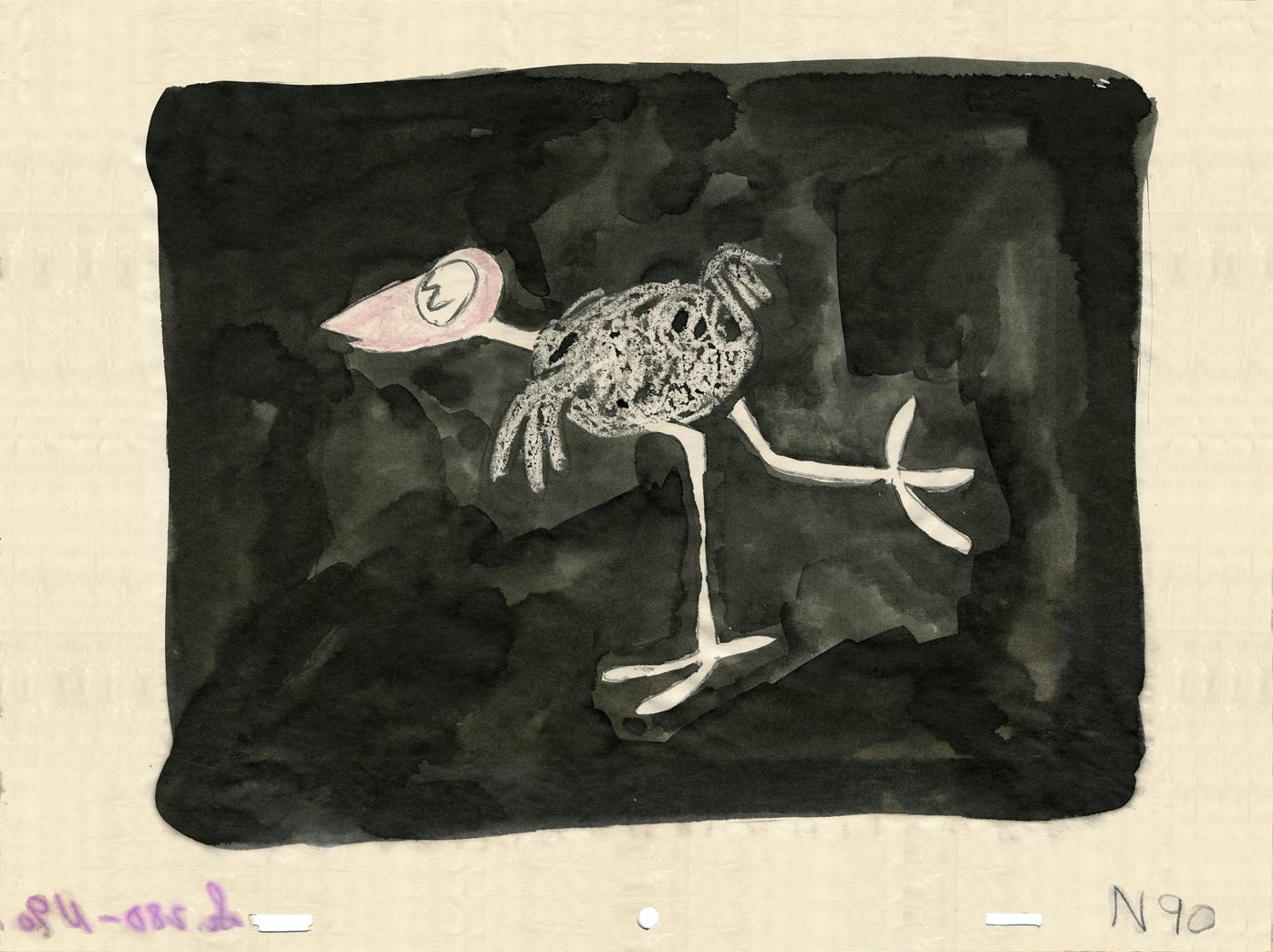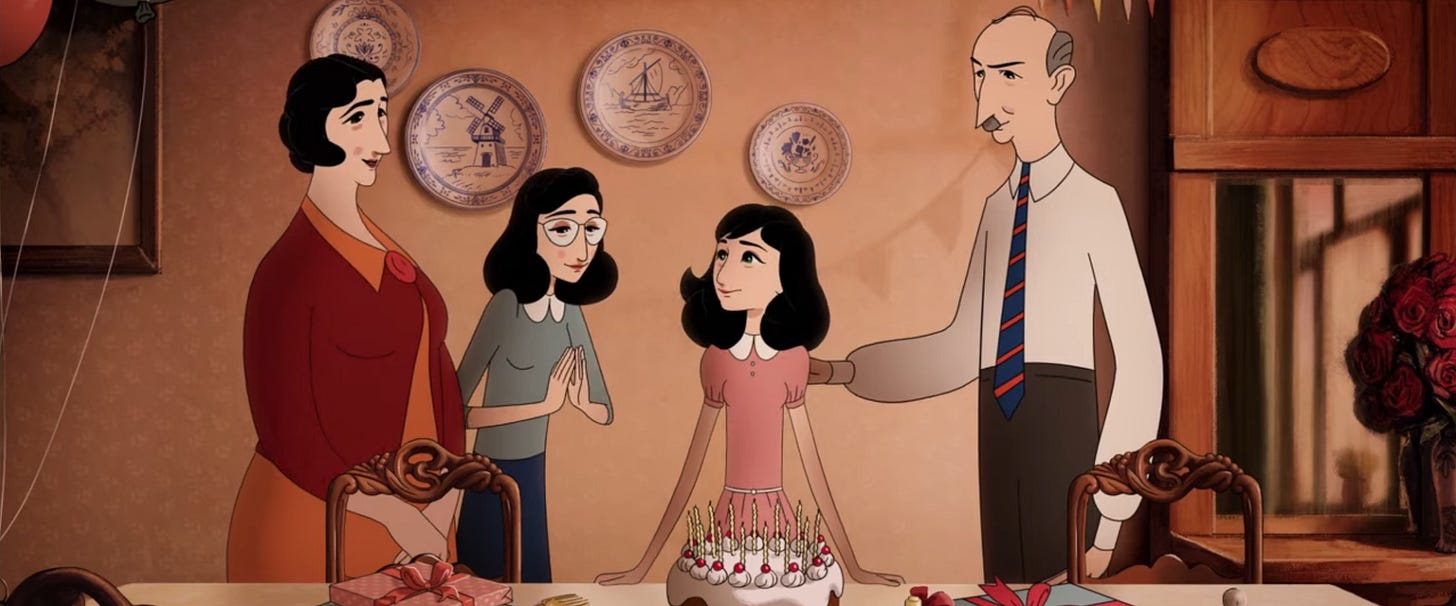When Indie Animation Won Its First Oscar
Plus: global animation news.
Welcome to another edition of the Animation Obsessive newsletter! Thanks for joining us. Here’s the menu for this week:
One — remembering the seminal Oscar winner Moonbird.
Two — animation news from around the world.
Three — the last word.
New to our newsletter? Signing up is free and takes zero effort — and you’ll be able to read new issues in your inbox as they launch, every Sunday:
Now, here we go!
1. The history-making Moonbird
It’s been almost 20 years since the Academy started giving out Oscars for feature-length animation. From then to now, big studios have ruled the award. Pixar and Disney have 14 wins — only Spider-Verse has broken their streak in the last nine years. Getting an Oscar means prestige and attention, but only animation with prestige and attention can win.
Still, what if an indie darling like The Secret of Kells or Loving Vincent had actually, somehow, stolen the Oscar?
That’s a good way of looking at Moonbird. When Faith and John Hubley released it back in 1959, big studios had an even tighter grip on the Oscars. The award for short animation, introduced in ‘32, had never gone to an independent cartoon. Moonbird made it possible. In doing so, it opened the floodgates for a new wave of indie animation.
But what is Moonbird, exactly? That’s a bit more complicated. The film made perfect sense in 1959 — but its context and visual fidelity faded away with time, obscuring the Hubleys’ achievement here. Newly restored versions like the one above, or Criterion’s amazing copy, help a lot. Still, they leave too much about Moonbird unexplained. Why are the visuals and dialogue so strange? Why does it move that way? What’s the point?
It all started on the spur of the moment, when Faith and John Hubley were with their children Marky (Mark) and Hampy (Ray). “We heard the boys plotting to go to the park and find a bird,” Faith said. “We all went to the studio with a bird cage, a bag of candy, and a shovel, and taped the soundtrack in three hours.”
Ray remembered “playing around on the floor and arguing and having fun” in the recording studio, as John Hubley himself pretended to be the Moonbird. The audio of their free-spirited, improvised play was then cut down to fit a 10-minute cartoon. It makes for dialogue that feels immediate, like Marky and Hampy are inventing Moonbird in front of you, live. It’s a deeply personal insight into the Hubley family.
None of this would have shocked audiences in ‘59. In the years leading up to Moonbird, the Hubleys had used this same recording technique for their iconic TV commercials for Maypo cereal. Marky starred there as well, sporting a hat like the one he’s wearing in Moonbird. A character resembling Hampy even showed up in one spot.
The difference is that Moonbird is the Hubleys set loose. It was a family production with no financial incentive — they funded it themselves, without so much as a grant. Money from the Maypo ads paid for half of it, but the film still “took about 25 years to pay off,” Faith said. Total independence meant total freedom to break the mold, and to make what John once called “the pure work.”
That included the visual style. John had defined the clean, sharp UPA look early in his career, but he changed direction after marrying Faith. They wanted to “develop the visual art even further than the UPA films had,” he later said. The old style was losing its luster — endless UPA copycats had “canceled out the novelty and brought about a ‘phoney’ tinge,” as one commentator put it in 1957.
Moonbird gets away from all of that. In place of the modernist shapes that had started to feel corporate, it adopts an organic, ethereal look. The Hubleys leaned on tricks they’d developed for their first indie cartoon, The Adventures of *, like wax resist and loose character animation. Not to mention the key to it all — double exposure. Here’s how the late Michael Sporn, who worked for the Hubleys, explained the technique:
They would take the relatively clean animation drawings … and would paint them black. By that, I mean they would paint all the free space, outside the borders of the character, with black oil paint. (The oil paint didn’t stretch or buckle or shrink the paper. It just took forever to dry and destroyed the cells of the painters’ brains.)
The cameraman … would shoot the background, then roll back the film and shoot the blackened characters as a double exposure.
Composited like this, the characters merge with their surroundings in an almost ghostly way. Meanwhile, the paint around them darkens and textures the backgrounds. The Hubleys’ innovation freed them from the old system of drawing on cels with hard ink outlines — they could do pencil, watercolor and even crayon animation straight on paper. It was a revolutionary trick, with a look that can’t quite be reproduced digitally.
The team behind this magic was small — so small that it was “laughable by mainstream production standards,” per one historian. Only two animators brought Moonbird to life. They were Ed Smith (assistant) and the freelance key animator Robert Cannon, known to friends as Bobe or Bobo.
Cannon was a UPA veteran like John Hubley. Unlike Hubley, Cannon was an animator himself — a visionary one, obsessed with movement. UPA’s Jules Engel once remarked that Cannon was “always thinking how to move characters, how to do a gesture that would be more meaningful.” Another associate noted Cannon’s instinct for “understanding the flow of things.”
Cannon was gentle and shy — Hubley was commanding and forceful. At UPA, they’d mixed like oil and water. But Cannon’s animation for Moonbird makes Hubley’s design sing. The movement of the Moonbird itself, according to Ray Hubley, had an unexpected source. “It’s absolutely my father’s gestures,” he said. “The way he runs. The way he shakes his head.”
Historian Michael Barrier cites a simple reason for Cannon and Hubley’s reunion. Hubley’s studio was now the one “making cartoons most like those Cannon had once directed” at UPA — quiet, sincere films about children. Here, Faith Elliott’s seismic influence is impossible to ignore. When the Hubleys married, everything that John worked on suddenly had a “lyric quality,” animator Shamus Culhane once wrote.
“Nothing in Hubley’s UPA films suggests such a poetic approach,” Culhane continued. “To me it is obvious that Faith supplied the missing ingredient.”
Moonbird’s tiny, unlikely coalition managed to strike gold. In 1960, the film won the Oscar in the animated short category — “ending decades of unchallenged studio dominance and announcing a new period of stylistic experimentation,” as one historian put it. Surveying the history of animation at the Oscars, Vulture recently called Moonbird a “radical departure in style from any of the [winners] before it.”
It was John Hubley’s first Oscar acceptance speech. He was gracious and to the point. “I must share this with five people: Bob Cannon, Ed Smith, Faith Elliott and Marky and Hampy,” he said.
Moonbird’s win marked the dawn of a new era. The next year’s winner was Munro, an artful anti-war cartoon directed by Gene Deitch, another UPA alumnus. A year later, the wild Ersatz picked up the prize. Neither film was made in the United States, let alone at a major Hollywood studio. Then, the Hubleys built on Moonbird and won again with The Hole in 1962.
In 1963, for the very first time, not one cartoon among the Oscar nominees came from a big studio.
Every year, you can still see Moonbird’s genes in the Academy’s animated-short category. With films like Bao, even major players like Pixar take more from Moonbird’s example than from the cartoons that preceded it. It’s not just that the Hubleys legitimized “indie animation.” It’s that Moonbird was a cartoon by the Hubleys — no one else could have made it.
That searing uniqueness, that testament to the power of personal animation, has inspired animators and kept Moonbird fresh for over 60 years. Here’s to 60 more.
2. Headlines around the world
The labor crisis in Japanese animation, redux
Last week, we wrote at length about the crisis unfolding in Japan’s animation industry. At its root are poor working conditions and worse pay, which have combined to cause a massive labor shortage. As one Japanese director said in 2019, there “are no more young animators.”
The issue has come to the fore in recent weeks. It started when animator Ippei Ichii criticized Netflix and the studio MAPPA earlier this month, accusing them of abysmal pay rates for staffers. A firestorm ensued, and it continued through this week — as MAPPA tried to control the damage.
Alluding to Ichii’s tweet without naming him, MAPPA issued a vague statement about leaks that “invite misunderstanding,” Anime News Network reports. Notably, the studio didn’t contest Ichii’s claim that animators were asked to work for the equivalent of $34 per scene.
Meanwhile, MAPPA unveiled its new branch — Studio Annex. Its stated purpose, per a translation from ANN, is to “improve the workplace environment”:
The lack of skilled animators has been worsening lately. One of the various causes is because skilled people in the anime and games industries have instead been going to China, which is in a good economic position. In order to secure the skilled talent, the workplace environment [in Japan] has to improve.
Currently, many studios make up for the missing Japanese animators in other ways. Foreign freelancers are finding more and more work, as we wrote last week. This week, though, a more uncomfortable story broke. Reacting to the labor shortage, the venerable Toei has started to use AI to create backgrounds. Adding the specter of automation to the mix may only deepen Japan’s labor crisis in the long run.
Where Is Anne Frank debuts at Cannes
Ari Folman, the Israeli director behind Waltz with Bashir, made a sudden splash this week with his new film Where Is Anne Frank. Its first trailer dropped on Wednesday, and the film itself just debuted at Cannes. Folman has been working on it for the last eight years.
This isn’t a strict adaptation of The Diary of Anne Frank. Per France 24, “Folman’s film follows Kitty, Anne’s imaginary friend from the diary, jumping between the present day and the real-life story of Anne and her family hiding from the Nazis in occupied Amsterdam.” Folman has aimed the film at young audiences — a response to the disastrous performance of his last film for adults, The Congress.
So far, reviews for Where Is Anne Frank have been positive. Based on the trailer, Folman’s approach to the design, animation and storytelling looks quite unique. We’ll be keeping an eye on this one as it nears wide release.
The first look at Disney’s Encanto
On Thursday, Disney dropped the first trailer for its 60th animated feature film, Encanto. From Zootopia co-directors Byron Howard and Jared Bush, Encanto takes place in a Colombia where magic is real. Lin-Manuel Miranda handled the songs. As a side note, artist Dylan Ekren wrote on Twitter what a challenge it was to “get em to let us put muscle on that character” — namely, a strongwoman who appears in the trailer.
Encanto is currently due out November 24.
Best of the rest
Hayao Miyazaki’s classic series Future Boy Conan is coming to America, via GKIDS. It’s a 4K restoration with dubbing in both Japanese and English.
In Japan, the president of Ufotable (Demon Slayer) has been indicted for evading corporate taxes — the equivalent of over $1.2 million.
Per a survey conducted by Soyuzmultfilm and Viber, Russia’s favorite cartoon character isn’t Winnie-the-Pooh or even Norstein’s hedgehog — it’s Matroskin, the cat from Three from Prostokvashino.
Meanwhile, market research from Crunchyroll suggests that “only 6% of Generation Z don't know what anime is, compared to 27% of the general population.”
Another from Russia — Soyuzmultfilm is making more moves to develop the animation industry in Novosibirsk, part of Siberia.
There’s now a museum dedicated to the history of Chinese animation. The China Cartoon and Animation Museum has opened in Hangzhou, Shine reports.
Catsuka shared a preview of the French film The Summit of the Gods. It’s directed by Patrick Imbert (The Big Bad Fox and Other Tales) and based on a manga series by Jiro Taniguchi.
3. Last word
That’s all for this week! Thanks for reading. A busy week of travel forced us to dial back this newsletter’s length a little — next Sunday, our regular format will return.
One last thing. We’re always on the hunt for interesting animation, and animation news, from around the world. If there’s something you think we should know about, please don’t hesitate to let us know:
Hope to see you again soon!






Ed Smith told me that Hubley calling his name from the Oscar podium was the proudest moment of his life.